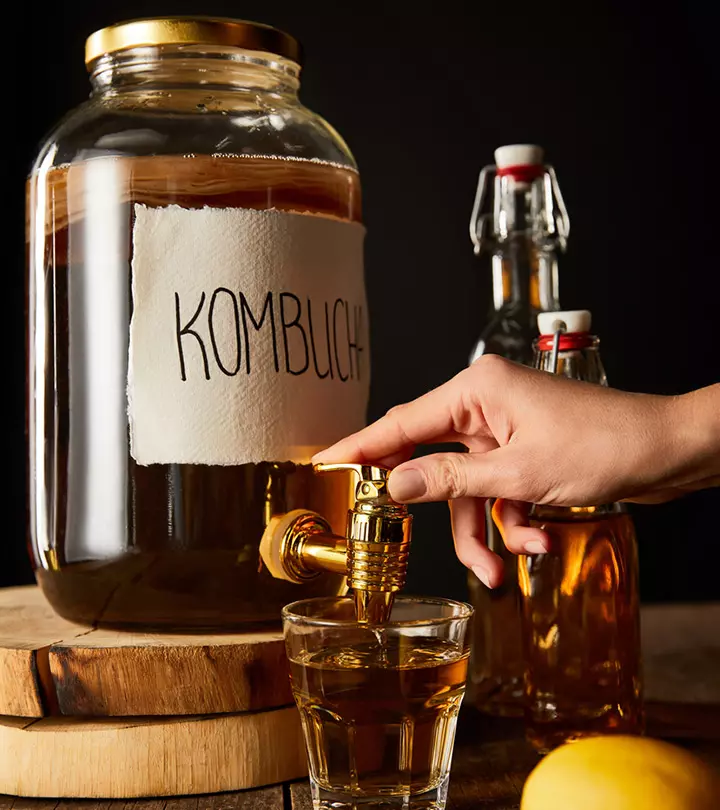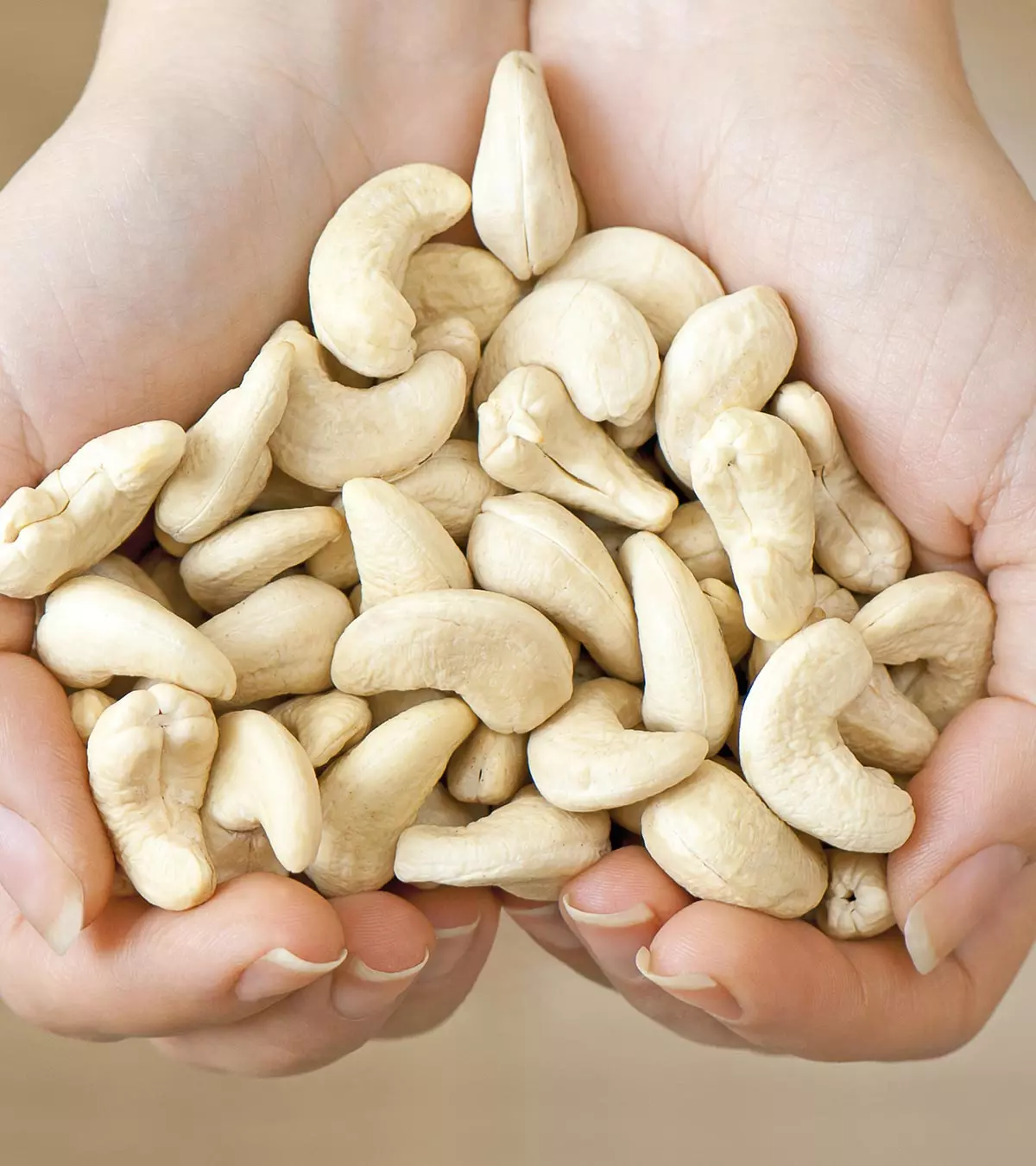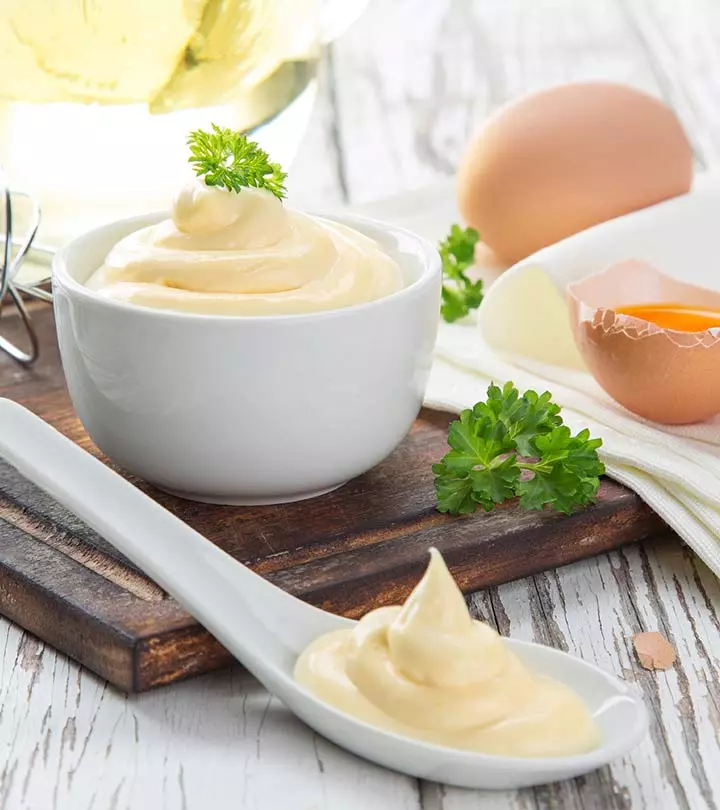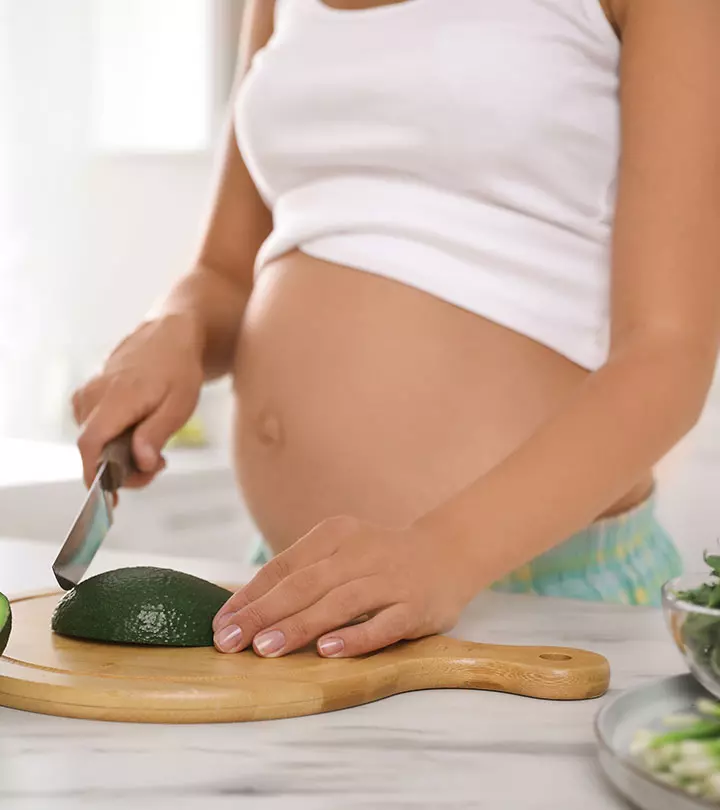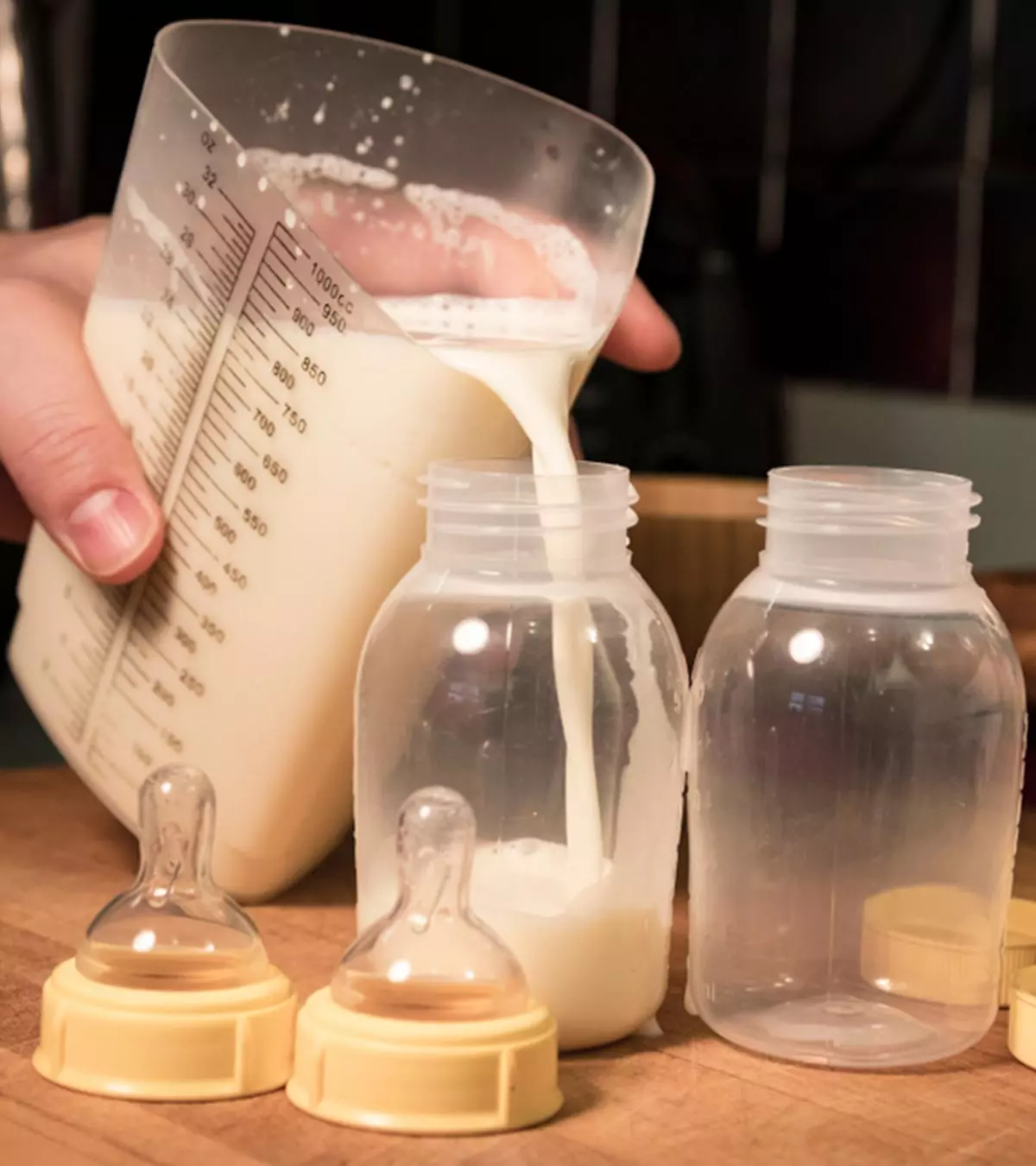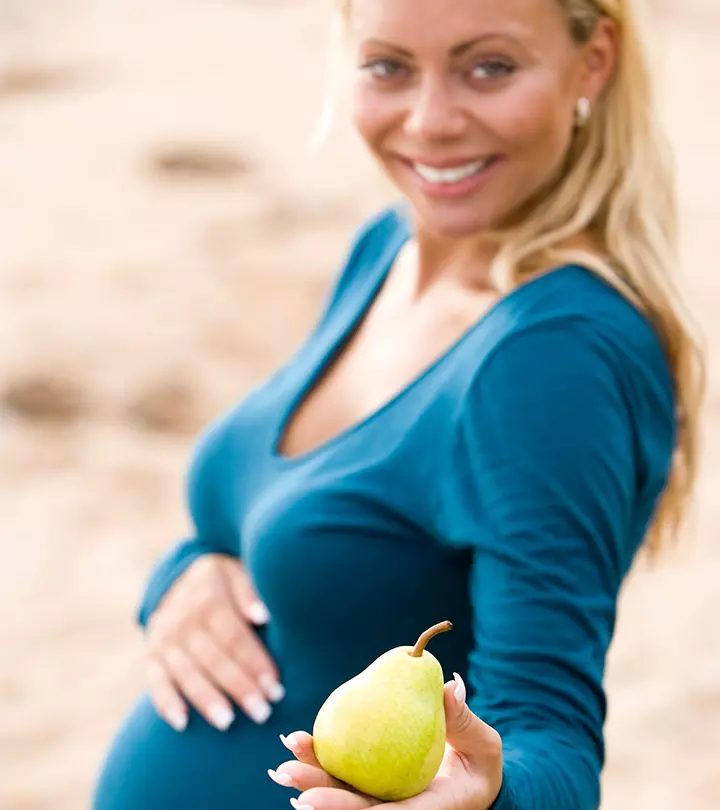
Image: Shutterstock
Cantaloupe is a melon belonging to the Cucurbitaceae family, consisting of watermelons and honeydews. The soft and sweet pulpy summer fruit may be something you would wish to feed to your baby. But while considering cantaloupe for babies, it is important to know about its safety and health aspects.

Besides being sweet and soft, cantaloupe is a nutrient-rich fruit and is easily digestible. However, before giving any food to your baby as part of a weaning diet, knowing its health benefits and safety is important.
Read on to know about cantaloupe, including how and when you should feed it to your baby, its health benefits, storage techniques, and healthy recipes.
Key Pointers
- You may give ripe cantaloupes to babies in the form of puree from six months of age.
- These fruits provide adequate hydration and are rich in vitamin A, C, potassium, magnesium, fiber, and antioxidants.
- Always wash the fruit thoroughly before feeding it to the baby.
- Some healthy recipes you can try are cantaloupe and banana puree, cantaloupe smoothie, etc.
When Can Babies Eat Cantaloupes?
Babies can consume ripe cantaloupe from the age of six months when they begin to consume other solid foods. You can first serve cantaloupe in mash or puree form. Once the baby can digest the fruit without any apparent concerns, you may add cantaloupe to other foods to raise their sweetness and overall nutritional value.
You can serve half-moon-shaped slices or wedges of cantaloupe to babies between nine and ten months. Once the baby’s pincer grasp refines between ten and 18 months, you may serve them small, bite-sized pieces to promote self-feeding. Since cantaloupe is a firm and slippery food, never leave your baby unattended while they are self-feeding.
Nutritional Value Of Cantaloupe
Cantaloupe is a muskmelon variety that can offer several nutrients, such as vitamins A and C, potassium, magnesium, and dietary fiber (1). One small wedge or slice (35g) of cantaloupe can offer the following nutrients to your baby (2)(3)(4).
| Nutrients | Amount | AI (7-12 months) |
|---|---|---|
| Water | 31.6g | – |
| Fiber, total dietary | 0.28g | – |
| Calcium, Ca | 3.15mg | 260mg |
| Magnesium, Mg | 4.55mg | 75mg |
| Phosphorus, P | 5.95mg | 275mg |
| Potassium, K | 55mg | 860mg |
| Sodium, Na | 10.5mg | 400mg |
| Vitamin C, total ascorbic acid | 3.82mg | 50mg |
| Folate, total | 4.9µg | 80µg |
| Vitamin A, RAE | 81.2µg | 500µg RAE |
AI = Adequate Intake – nutrient level assumed to ensure nutritional adequacyRAE = Retinol Activity EquivalentsSource: USDA and Oregon State University
Possible Health Benefits Of Cantaloupe For Babies
Consuming cantaloupe can be beneficial for the babies in the long run. Below are some notable properties of cantaloupe that reflect its long-term benefits.
- Provides hydration: One slice (35g) of cantaloupe offers about 31.6g of water, meaning almost 90 percent of the fruit is water (2). This water content could provide supplemental hydration, beyond breast milk or formula, to babies older than six months. Staying hydrated is imminent for babies, especially during summers.
- Offers nutrients: Cantaloupe is rich in vitamins and minerals, such as vitamins A and C, potassium, and folate. While vitamin A is vital to maintain healthy skin and support eye development (5), vitamin C boosts immunity and promotes wound healing (6). Folate is necessary for blood cell and DNA production (7), and potassium for healthy bone growth and maintaining electrolyte balance (8).
- Supplies antioxidants: SeleniumiAn essential mineral found in foods such as nuts, fish, and chicken, involved in thyroid, reproductive, and cell-protective functions. , zeaxanthiniColored pigment, derived from leafy vegetable and egg yolks, found in the eye retina for its protection against the common eye problems. , luteiniA colored pigment found in the eye and responsible for filtering light and protecting the eye from sunlight damage. , beta-caroteneiA precursor of vitamin A, it is a richly colored pigment that lends a yellow/orange color to fruits and vegetables. , vitamin A, and vitamin C are powerful antioxidants found in cantaloupe (2). Antioxidants promote overall health by combating free radical damage at the cellular level. Offering an antioxidant-rich diet from an early age boosts immunity and maintains health in the long run.
- Beats constipation: Cantaloupe contains water and dietary fiber that can keep your infant’s bowel movements regular. Healthy bowel movements ensure the solid food and breast milk or formula are digested effectively, preventing constipation in babies.
Beyond these benefits, studies indicate that cantaloupe could have anti-inflammatory, antimicrobial, hepatoprotectiveiAgents that protect the liver from any damage and improve its function. , and immunomodulatoryiA substance that stimulates or suppresses the immune system. effects, too (1).
 Quick fact
Quick factSteps To Store And Select Cantaloupe
Melons grow on the ground and are at risk of contamination with pathogens, such as bacteria.
Therefore, proper selection and storage of cantaloupe are preeminent for its safe consumption.
Steps to select cantaloupe
- Buy organic cantaloupe from a reputable retailer or well-maintained farmer’s market.
- Select a round-shaped cantaloupe with clean, raised, and cream-colored netting on the outer surface or peel.
- Hold a cantaloupe in your hands and select the one that feels full and heavy on touch as they are most likely to be ripe.
- Tap the cantaloupe and listen to the sound it makes. A dull and deep sound indicates that the cantaloupe is ripe. In contrast, if the sound is high and shallow, the fruit is likely unripe.
- The smell is another way to check the cantaloupe’s ripeness. A soft, musky scent indicates the fruit is fully ripe, and one must consume the cantaloupe within a couple of days.
- Discard cantaloupe that looks bruised or mushy or has deep cracks in the rind. Such cantaloupe may be infested with pests.
- Purchase whole cantaloupe instead of half-cut pieces, which pose a high risk of contamination.
Steps to store cantaloupe
- Let an unripe cantaloupe stay at room temperature for three to four days until it turns soft.
- Eat ripe cantaloupe the day you purchase it. If not, store it in the refrigerator at 32 to 36°F (0 to 2.2°C) for no longer than two to three days.
- Store chopped cantaloupe pieces in a glass or BPA-free plastic container placed within a refrigerator.
- Keep whole and cut cantaloupe away from ethylene-sensitive fruits and veggies to avoid odor transfer and over-ripening or premature ripening.
Precautions To Take While Feeding Cantaloupe To Babies
Below are some safety precautions to ensure cantaloupe’s safe consumption in babies.
- Introduce peeled and deseeded cantaloupe in puree or mash form to your baby. As the baby adjusts to the fruit’s taste and digestibility, add different cantaloupe recipes to your baby’s weaning diet.
- Wash the cantaloupe thoroughly before you cut or peel it to feed your baby. It minimizes the risk of fruit contamination with harmful bacteria, such as listeria and salmonella.
- Before feeding mash or puree, ensure it is smooth and lump-free. It will help easy swallowing and avoid choking. The American Academy of Pediatrics (AAP) states that food causes more than 50% of choking incidents in children, emphasizing the importance of serving food properly.
- Do not add sweeteners to the mash or puree to let the baby adjust to the fruit’s natural taste and flavor.
- Feed a teaspoon or two of homemade cantaloupe puree or mash in a meal. Then, gradually increase the quantity to a tablespoon or two.
- Follow a “three to five-day wait” rule to note any signs of allergy or intolerance.
- Discontinue feeding if the baby looks uncomfortable after ingesting a cantaloupe. Reintroduce after some time, say two to three days. In case the problem persists, consult a pediatrician.
- Allergy to cantaloupe in the form of oral allergy syndrome or food-pollen allergy syndrome is common. The symptoms of an allergic reaction that may come up shortly after touching or ingesting cantaloupe are tingling of the lips or itching of the mouth, itchy skin and skin rashes (hives), nasal congestion, coughand wheezing, vomiting and diarrhea (9).
- If your baby has a family history of allergies, especially with those of latex, ragweed pollen (zucchini, banana, and cucumber), or grass pollen allergy (celery, tomato, peaches, and oranges), then consult your healthcare provider before introducing cantaloupe to your baby (10).
- Never use a melon ball scooper to make cantaloupe scoops for babies, as they are a potential choking hazard.
- Avoid over-feeding cantaloupe to babies and toddlers since its high water content may fill up their tiny tummies quickly, causing them to skip the next meal. It may also cause an upset stomach or diarrhea in sensitive babies and toddlers.
Healthy Cantaloupe Recipes For Babies
Here are some age-appropriate cantaloupe baby food ideas you could try.
1. Cantaloupe puree (6 months+)
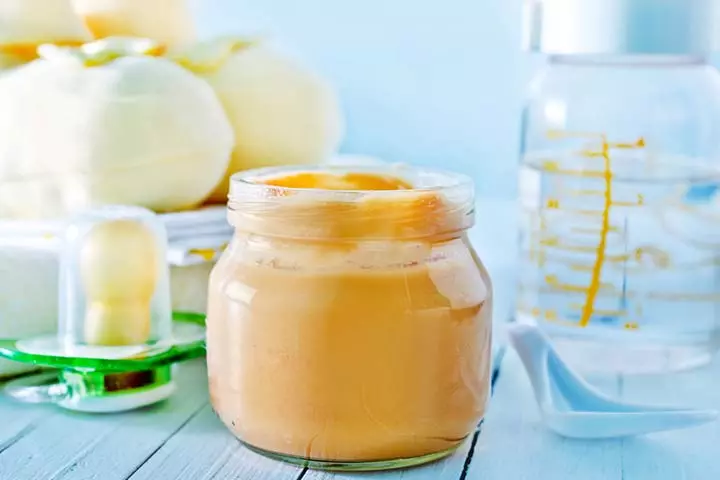
You will need:
- 1 cantaloupe/muskmelon slice (peeled, deseeded, and chopped)
How to prepare:
- Put cantaloupe pieces into a blender and blend into a lump-free, smooth puree.
- Feed the puree to your baby immediately.
2. Cantaloupe and banana puree (8 months+)
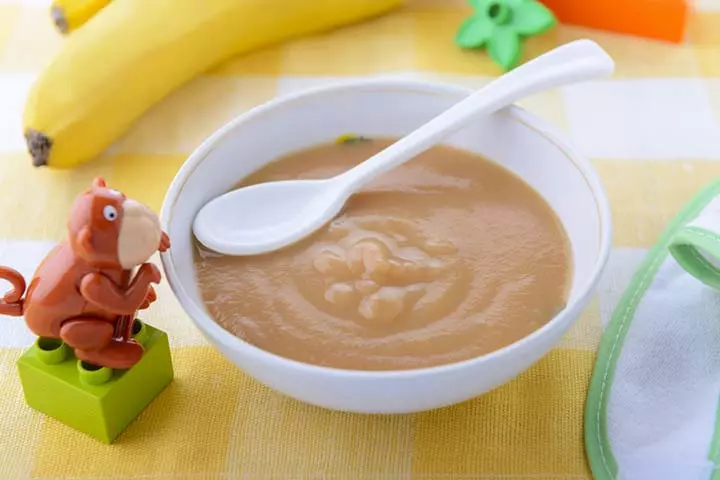
You will need:
- ¼ cup cantaloupe (peeled, deseeded, and chopped)
- ½ banana (peeled and chopped)
- ½ tsp dry fruits powder
- Breast milk or formula
How to prepare:
- Blend cantaloupe and banana into a smooth, lump-free puree using a blender.
- Add dry fruit powder and blend again. Add breast milk and formula to adjust consistency.
- Feed immediately to get the best flavor.
3. Cantaloupe salad (10 months+)

You will need:
- ½ cup cantaloupe (peeled, deseeded, and chopped into cubes)
- ¼ cup strawberries (chopped into small cubes)
- ¼ cup kiwi (chopped into small cubes)
- ¼ tsp fresh lemon juice
- Pinch of black salt
How to prepare:
- Put the fruits in a salad bowl. Add lemon juice and black salt and give a nice toss.
- Transfer some salad into a serving bowl and let your baby hone their pincer grasp with this incredibly simple, refreshing, and healthy finger food recipe.
4. Cantaloupe smoothie (12 months+)
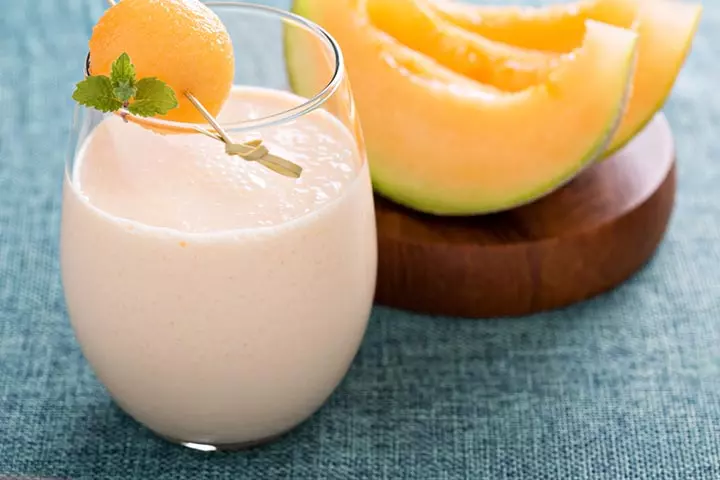
You will need:
- 1 cup cantaloupe (peeled, desserts, and chopped)
- ½ cup frozen mango (chopped)
- ½ cup unsweetened Greek yogurt
- ½ cup almond milk
- 1 frozen banana (chopped)
- 1tsp dry fruits powder
How to prepare:
- Put all the ingredients in a blender and blend until you get a smooth-flowing, lump-free smoothie.
- Pour the smoothie in a feeding cup and let your baby self-feed.
 Quick tip
Quick tip5. Cantaloupe lemon popsicles (12 Months+)
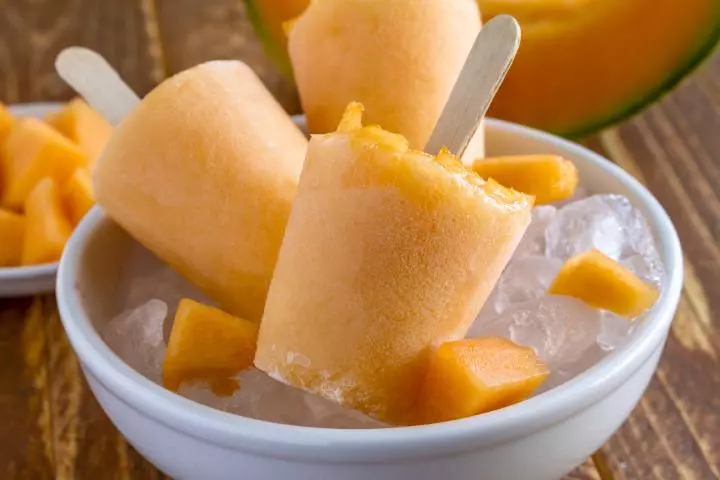
You will need:
- 1 small cantaloupe
- ½ cup fresh squeezed lemon juice
- 1 cup plain yogurt
- Maple syrup or honey as a sweetener (optional)
How to prepare:
1. Cut the cantaloupe into half, scoop out the seeds, and peel the skin. Then, cut it into small cubes.
2. In a blender, add cantaloupe pieces and yogurt and blend them well.
3. Add maple syrup or honey to the mix, if needed.
4. Add lemon juice and mix well.
5. Pour the mixture into popsicle molds.
6. Keep the popsicle tray in the fridge overnight or at least for five hours.
7. Keep the mold under running water to un-mold the popsicles easily.
8. Offer it to your baby as a healthy finger snack or dessert to enjoy.
Frequently Asked Questions
1. Can I feed my baby cantaloupe seeds?
When feeding cantaloupe pulp to babies, it is advisable to remove all seeds. However, the seeds may be separately cleaned, dried, and roasted. They are edible and may be added to baby food in powdered or paste form to contribute to the baby’s overall nutritional needs.
2. Can I give my baby cantaloupe as a snack?
Yes, cantaloupe can be cut into different shapes and given to older babies as finger food or snack between meals. You may also offer cantaloupe prepared as salads or smoothies to toddlers.
Anumeha, a mom of two, serves cantaloupe as finger food to her ten-month-old daughter. She says, “I roll up her sleeves, put two bibs, and keep one piece of the food on her table. Imagine cutting a crescent-shaped piece of a cantaloupe and keeping it on your child’s table. My daughter relished it. The juice flowed down her wrist into her sleeves. Her whole mouth was sticky. But you know what? Her eyes were twinkling as if she had had the best meal ever! She just loved it (i).”
3. Can I mix cantaloupe with breast milk or formula for my baby?
Yes, you may use breast milk or formula while making cantaloupe puree for babies.
4. What should I do if my baby refuses to eat cantaloupe?
Take a break and try again after a few days. Look out for symptoms of food allergies in babies or any discomfort that may be the reason your baby refuses to eat cantaloupe (11).
5. Can babies choke on cantaloupe?
Cantaloupe can be a choking hazard as it is firm and slippery. The risk particularly exists when cantaloupe is served as melon balls (made with a melon ball scooper). The risk may be minimized by serving cantaloupe in half-moon shape or wedges or made into purees which are also easy to digest for babies.
Cantaloupe for babies can be a nutritious addition to their meals after they start their solid food intake. Its soft texture is easy to swallow and digest for babies and toddlers. Additionally, it contains ample nutrients that can provide for the healthy development of your baby by aiding in their immunity, digestion, and more. You are good to go if you include appropriate amounts for their age and easily chewable forms such as puree or mash. So go ahead and try out different recipes for these juicy and delicious fruits for your baby.
Infographic: Some More Cantaloupe Baby Food Ideas
Once you are sure that your baby is tolerating cantaloupe well, you may bring in more varieties to the flavor by combining cantaloupe with other fruits and vegetables. The infographic below lists some delicious cantaloupe recipes for your little one.
Some thing wrong with infographic shortcode. please verify shortcode syntax
Illustration: Cantaloupe (Muskmelon) For Babies: Benefits And When To Give
_for_babies_benefits_and_when_to_give_illustration.jpg.webp)
Image: Stable Diffusion/MomJunction Design Team
Discover 8 delightful and effortless techniques to introduce cantaloupe to your infant. Follow our user-friendly video guide to effortlessly prepare and offer this delectable fruit to your little bundle of joy.
Personal Experience: Source
MomJunction articles include first-hand experiences to provide you with better insights through real-life narratives. Here are the sources of personal accounts referenced in this article.
i. How I feed my daughter (10 months old) inspired by Ayurveda.https://enjoyingyourkids.com/2015/02/11/how-i-feed-my-daughter-10-months-old-in-ayurvedic-style/
References
- Filomena Monica Vella et al.; Characterization of Polyphenolic Compounds in Cantaloupe Melon By-Products; NCBI
https://www.ncbi.nlm.nih.gov/pmc/articles/PMC6617032/ - Cantaloupe, raw, FDC ID: 1102655; Food data Central; USDA
https://fdc.nal.usda.gov/fdc-app.html#/food-details/1102655/nutrients - Potassium; Oregon State University
https://lpi.oregonstate.edu/mic/minerals/potassium#AI - Dietary Guidelines for Americans, 2025-2025; USDA
https://www.dietaryguidelines.gov/sites/default/files/2025-12/Dietary_Guidelines_for_Americans_2020-2025.pdf - Vitamin A; Harvard
https://nutritionsource.hsph.harvard.edu/vitamin-a/ - Anitra C. Carr; Vitamin C and Immune Function; MDPI
https://www.mdpi.com/2072-6643/9/11/1211 - Folate (Folic Acid) – Vitamin B9; Harvard
https://www.hsph.harvard.edu/nutritionsource/folic-acid/ - Potassium; Harvard
https://nutritionsource.hsph.harvard.edu/potassium/ - Food Allergy to Melons?; American College of Allergy Asthma & Immunology
https://acaai.org/resource/food-allergies/ - Oral Allergy Syndrome (OAS); American Academy of Allergy Asthma & Immunology
https://www.aaaai.org/tools-for-the-public/conditions-library/allergies/oral-allergy-syndrome-(oas) - Your baby’s first solid foods; NHS
https://www.nhs.uk/conditions/baby/weaning-and-feeding/babys-first-solid-foods/#
Community Experiences
Join the conversation and become a part of our nurturing community! Share your stories, experiences, and insights to connect with fellow parents.
Read full bio of Shivani Sikri
Read full bio of Swati Patwal
Read full bio of Rohit Garoo
Read full bio of Ghazia Shah






